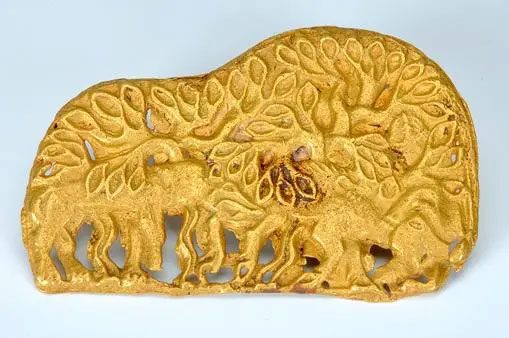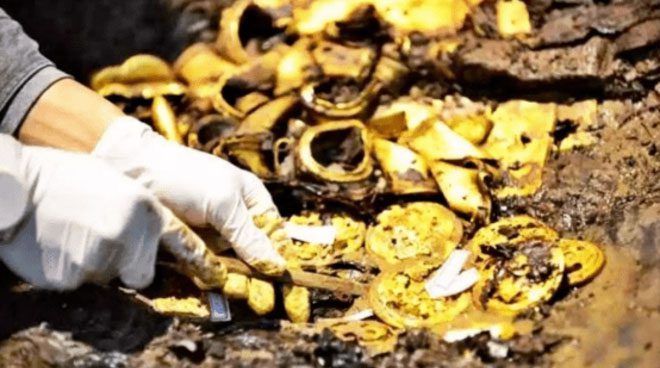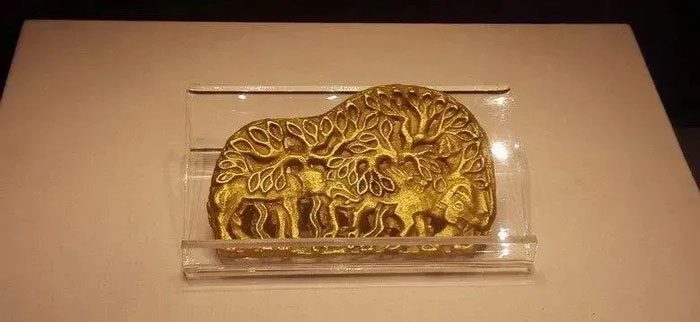In 1994, in Kyi Li County, part of the Tibetan Autonomous Prefecture of Haibei in Qinghai Province, China, a strange incident occurred.
Specifically, one day, a shepherd named Ma Tianfu was herding his sheep in the meadows as usual. With years of experience in livestock management, Ma was very familiar with his flock, so he didn’t need to keep a close watch while they grazed. He decided to lie down and rest on the grass, occasionally glancing at the sheep to ensure none wandered off.
However, while lying on the grass, Ma suddenly heard a strange noise, resembling the sound of a sheep.
Looking down, Ma discovered a yellow stone and quickly picked it up to inspect it. After wiping off the dirt, this shepherd believed it must be a piece of gold, and he even thought it could be quite valuable because it had intricate patterns.

The shepherd was thrilled to find a piece of gold in the meadow.
Ma was extremely excited and quickly herded his sheep back home. When his wife saw him returning early, she hurried to ask what happened. Ma directly showed her the piece of gold and explained that he had found it while tending to the sheep.
Ma Tianfu told his wife that they had struck it rich because if they sold this piece of gold, they would get a lot of money. Early the next morning, Ma took a bus to a large gold shop and asked the owner how much the gold he found was worth.
After examining the piece of gold, the owner asked Ma where he had obtained it. To avoid trouble and suspicion from others, Ma lied and said that the gold had been passed down from his ancestors.
The shop owner was skeptical and told Ma Tianfu that his gold looked like an artifact, so he should consult with experts in antiques.
Thus, Ma Tianfu went to the local Cultural Heritage Bureau to find an expert who could appraise the value of the gold piece. If it was truly a treasure, he could sell it for a very high price.
When experts examined it closely, they discovered that this was not an ordinary piece of gold. Instead, it was a cultural relic.
The truth about the gold in the meadow
After further inspection, the experts determined that this piece of gold was actually a burial artifact buried underground. The weight of the gold was not light, so using it as decoration or daily jewelry would be very impractical for the nomadic people living in the meadows. Therefore, it could only be an object used in funerals.
The discovery of this gold was a sign that there might be an ancient tomb or a sacrificial site nearby. Consequently, the archaeological team quickly traveled to the meadows in Kyi Li County, where Ma Tianfu lived and tended his sheep daily. After Ma pointed out the location where he found the gold, the archaeologists conducted analysis, defined the specific area, and began excavation. Indeed, they discovered many artifacts made of gold and silver. All these artifacts were identified as originating from the Han Dynasty (206 BC – 220 AD).

Experts found many gold artifacts at the site where Ma herded sheep.
The piece of gold that Ma Tianfu found features very unique and intricate patterns. On the gold, one can see a wolf chasing and attacking a cow, reflecting a natural law.
The carvings are very vivid, showcasing the high skill level of the craftsmen at that time.

The gold piece, dated to about 1,800 years ago, is currently displayed at the Qinghai Provincial Museum (China).
Along with related historical records, experts analyzed the artifacts found here and concluded that they belonged to the nomadic people who once lived in Kyi Li County. However, this was only a branch of the Xiongnu people. After their alliance with the Northern Wei Dynasty (386 – 534 AD) was broken, this tribe eventually collapsed. To this day, only in Qinghai, Gansu, and a few other places have experts been able to discover some historical traces of this tribe.
The experts later tried to persuade Ma Tianfu to return the gold to the authorities, as it is a priceless treasure with significant research value. Ma Tianfu agreed to return the ancient gold. He was also praised by the local Cultural Heritage Bureau and awarded some money for his discovery of the cultural relic and his willingness to return it.




















































